Beef Bulgogi
- By Jennifer Segal
- Updated March 5, 2025
- 84 Comments
- Leave a Review

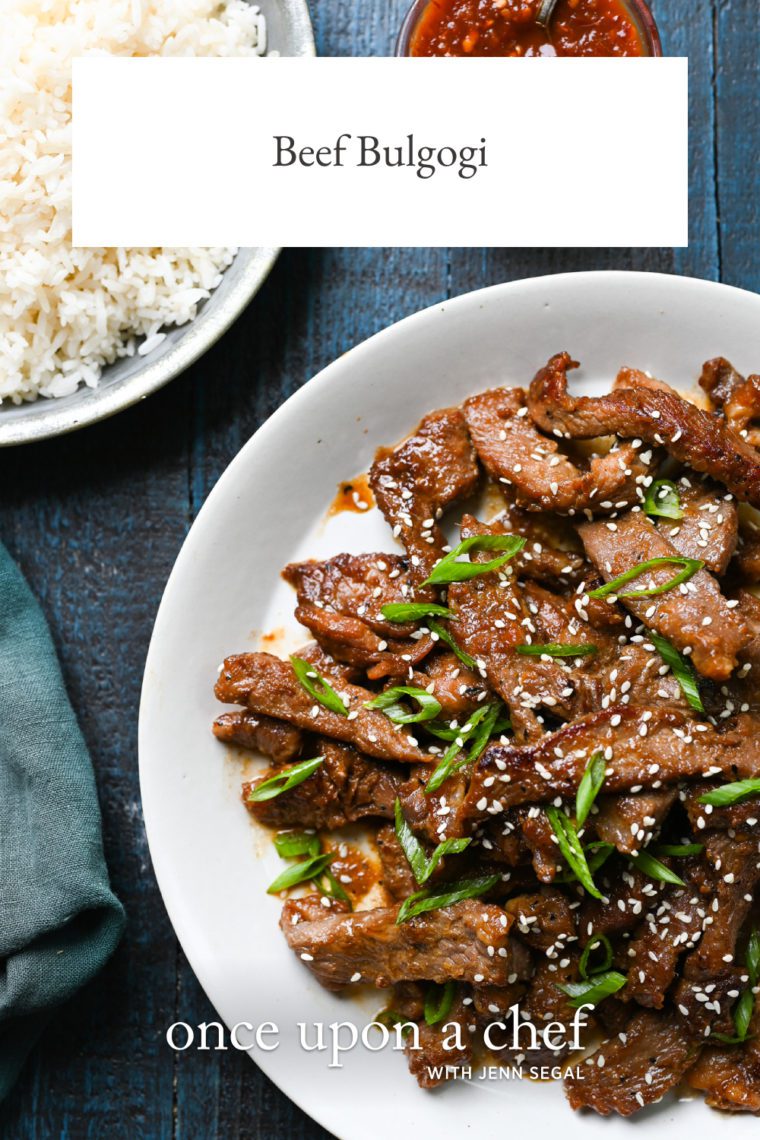
This post may contain affiliate links. Read my full disclosure policy.
Add a little sizzle to your weeknights with this easy bulgogi recipe—a Korean favorite that cooks in a flash and fills your kitchen with an irresistible aroma. Thinly sliced marinated ribeye delivers a perfect mix of sweet and savory notes that make dinner truly special.
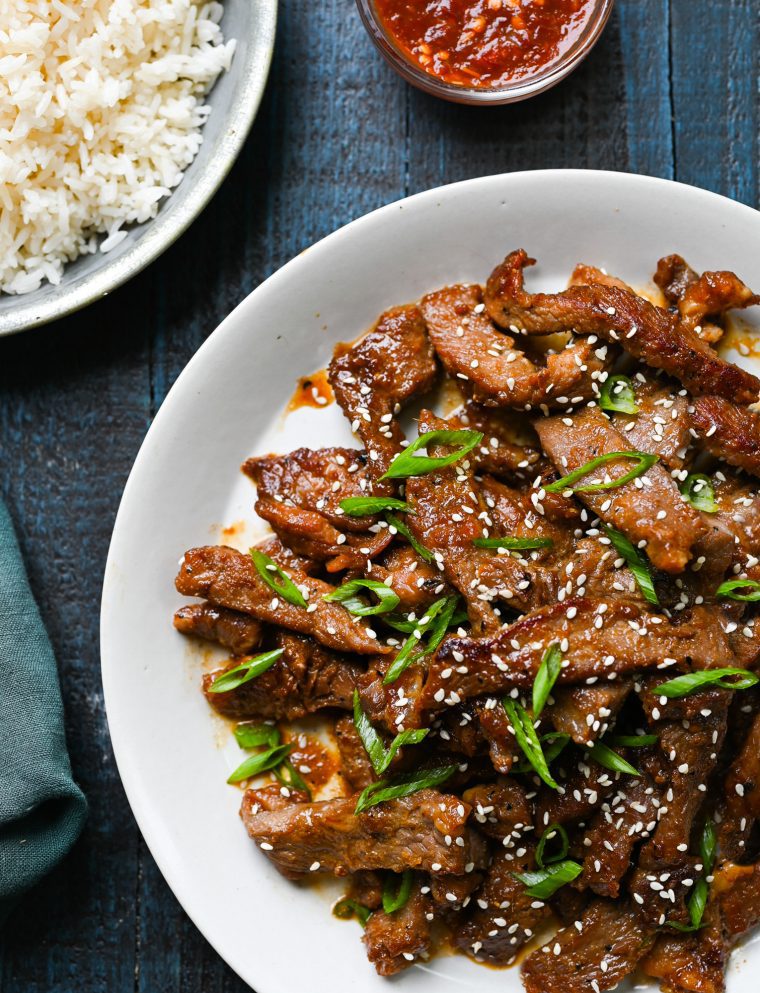
Bulgogi, pronounced bool-goh-gee, is a popular Korean barbecue dish that translates to “fire meat.” It’s made of thinly sliced marinated meat, typically beef, that’s grilled on a barbecue or stovetop griddle. Despite its name, bulgogi is not really spicy; “fire” refers to the hot cooking surface.
In many Korean restaurants, tables are outfitted with grills in the center so customers can cook the bulgogi meat themselves and eat it straight from the grill. It’s typically served with steamed rice, lettuce wraps, chili sauce, and other traditional Korean accompaniments.
Making bulgogi at home is surprisingly easy. In this version, adapted from Cooks Illustrated, well-marbled ribeye is marinated in a mixture of soy sauce, brown sugar, sesame oil, garlic, shallot, ginger, and red pepper flakes. Instead of grilling the meat, which can be tricky unless you have a flat-top grill, I cook it in a cast iron or nonstick pan.
Heads up: the smell of bulgogi sizzling on the stove will have your family circling the kitchen like hungry wolves. Conveniently, it cooks in under 10 minutes, so no one will have to wait too long!
Love these flavors in this Korean steak dish? Try my Beef Bulgogi Burgers next—they’re a great way to jazz up burger night.
“Made it to the recipe but doubled the marinade as one reviewer suggested. Wow! This recipe is delicious!! Served it with some Jasmine rice and I can’t wait to make it again!!”
What You’ll Need To Make korean Beef Bulgogi

- Ribeye Steaks: Ribeye is ideal as it’s well-marbled with fat, making it tender and tasty. However, bulgogi can be made with many cuts of meat, including ribeye, short ribs, sirloin, or beef tenderloin. If you happen to live near a Korean or Japanese supermarket and want to skip a step, both typically sell pre-sliced Bulgogi beef.
- Baking Soda: Tenderizes the beef and also helps with browning and caramelization.
- Vegetable Oil: Using a neutral-flavoared oil like vegetable oil allows the flavors of the marinade to really shine through.
- Sesame Oil: I add a small amount to the marinade for a nutty, rich flavor. Look for toasted (Asian) sesame oil, which is dark in color and nutty in flavor, not the light, untoasted variety.
- Soy Sauce: Flavors the marinade with umami and saltiness, which deeply seasons the meat. If you need gluten-free, use tamari or a gluten-free soy sauce instead.
- Dark Brown Sugar: Adds sweetness to the marinade, balancing the salty flavors of the soy sauce and enhancing the caramelization of the meat when cooked.
- Garlic, Shallots, and Ginger: These aromatics contribute depth and complexity to the marinade, infusing the meat with traditional Korean flavors.
- Crushed Red Pepper Flakes: Introduce a hint of heat to the dish. It’s not much but if you are sensitive to spice you can leave it out!
- Garnish: Green onions contribute a fresh, crisp boost of color and a mild oniony flavor to complement the rich meat while sesame seeds finish the dish with a slight crunch and enhances the sesame flavor in the dish.
- Jump to the printable recipe for precise measurements
How to Make Beef Bulgogi Step-By-Step
The prep for this easy beef bulgogi recipe is pretty quick, though you’ll need to allow time for the steak to freeze before slicing and, of course, marinating. So grab all your ingredients and a cast iron skillet and get ready to make a tasty Korean bulgogi!
Step 1: Slice the steak. Cut your ribeye steak into ¼-inch-thick slices. An easy trick I use for slicing steak thinly is to freeze it for about 35 minutes, just until it’s semi-firm. This process makes even-sized thin slices much easier to achieve.

Step 2: Soak the beef. Combine 1½ tablespoons of water with the baking soda in a medium bowl. Add the beef, toss to coat, and let it sit at room temperature for 5 minutes. This step is key because the baking soda helps tenderize the meat while also promoting browning and caramelization.

Step 3: Make the marinade. Use a mini food processor or blender, to process the vegetable oil, sesame oil, soy sauce, sugar, garlic, shallot, ginger, and red pepper flakes until smooth.

Step 4: Marinate the beef. Pour the bulgogi marinade over the beef and toss to coat. Cover with plastic wrap and marinate in the fridge for at least 1 hour or overnight.

Step 5: Cook the beef. Heat 2 teaspoons of oil in a large cast iron or nonstick skillet over medium-high until very hot and shimmering. The pan should be hot enough that the meat sizzles on contact. Add half of the beef in a single layer and cook, undisturbed, until browned on one side, 2 to 3 minutes.
Pro Tip: Turn on the exhaust fan before cooking the beef! Things are going to get a bit smoky when cooking the beef over high heat.

Step 6: Finish Cooking. Stir the beef and continue cooking until it is just cooked through, about 1 to 2 minutes more. Transfer it to a serving platter and cover it to keep warm. Cook the remaining beef along with any leftover marinade.

Step 7: Serve. Transfer the second batch of beef to the platter and sprinkle with the scallion greens and sesame seeds. Serve immediately with your favorite side dishes.
Bulgogi beef goes great with jasmine rice or basmati rice depending on what you have on hand, and a side of kimchi, steamed broccoli or Asian slaw.

pro tips for the best beef bulgogi
- Freeze the Beef: This makes slicing the beef so much easier. It only needs about 30 minutes or so in the freezer.
- Marinating: Bulgogi beef should be sliced very thin so it only needs one hour to soak up the marinade. However, you can leave it overnight if you want. This is handy if you want to save some time and prep the meat up the day before.
- Hot Skillet: It’s essential that your skillet is very hot before you add the beef. This ensures that your beef bulgogi browns and caramelizes nicely. Wait until the oil is shimmering to add the beef. It should sizzle as soon as it hits the pan.
- Storing Leftovers: Store leftover beef bulgogi in the refrigerator for up to four days or the freezer for up to three months. Thaw it out and then reheat in a hot skillet with a bit of oil until heated through.
- Meat Variations: Beef bulgogi is the traditional meat for this dish but it would work well with chicken thighs too.
Video Tutorial
More Asian-Inspired Beef Recipes to try
Beef Bulgogi
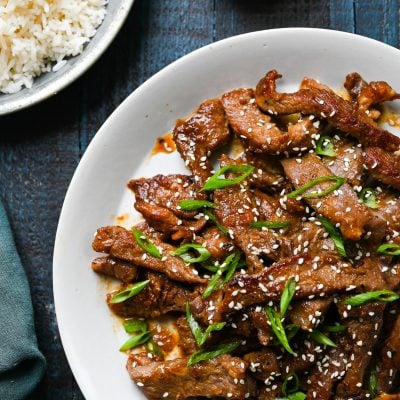
Ingredients
- 2 pounds ribeye steaks
- Heaping ¼ teaspoon baking soda
- 1½ tablespoons vegetable oil, plus 2 teaspoons more for cooking
- 1½ teaspoons sesame oil
- ¼ cup soy sauce
- 3 tablespoons (packed) dark brown sugar
- 2 cloves garlic, roughly chopped
- 1 small shallot, roughly chopped
- 1 tablespoon roughly chopped fresh ginger, from a 1-inch (2.5-cm) knob (see note)
- Heaping ¼ teaspoon crushed red pepper flakes
- 2 scallions, dark green parts only, thinly sliced, for serving
- 1 teaspoon sesame seeds, for serving
Instructions
- If time allows, place the steaks on a large plate and freeze until semi-firm, about 35 minutes (this makes them easier to slice). Slice the steaks into ¼-inch (6-mm)-thick slices.
- Combine 1½ tablespoons of water and the baking soda in a medium bowl. Add the beef slices and toss to coat. Let sit at room temperature for 5 minutes.
- Meanwhile, in a mini food processor or blender, combine the 1½ tablespoons vegetable oil, sesame oil, soy sauce, sugar, garlic, shallot, ginger, and red pepper flakes; process until smooth. Pour the mixture over the beef and toss to coat evenly. Cover with plastic wrap and marinate in the refrigerator for at least 1 hour or overnight.
- Turn on the exhaust fan. In a large (12-inch/30-cm) cast iron or nonstick skillet over medium-high heat, heat the remaining 2 teaspoons of oil until very hot and shimmering. Add half of the beef slices in a single layer and cook, without stirring, until browned on one side, 2 to 3 minutes. Stir the meat and continue stir-frying until the beef is just cooked through, 1 to 2 minutes longer. Transfer the beef to a serving platter and cover to keep warm; repeat with the remaining beef (no need to add more oil to the pan), adding any marinade left in the bowl to the pan right before stirring the meat. Transfer the second batch of beef to the serving platter and sprinkle with the scallion greens and sesame seeds. Serve immediately.
Notes
Pair with
Nutrition Information
This website is written and produced for informational purposes only. I am not a certified nutritionist and the nutritional data on this site has not been evaluated or approved by a nutritionist or the Food and Drug Administration. Nutritional information is offered as a courtesy and should not be construed as a guarantee. The data is calculated through an online nutritional calculator, Edamam.com. Although I do my best to provide accurate nutritional information, these figures should be considered estimates only. Varying factors such as product types or brands purchased, natural fluctuations in fresh produce, and the way ingredients are processed change the effective nutritional information in any given recipe. Furthermore, different online calculators provide different results depending on their own nutrition fact sources and algorithms. To obtain the most accurate nutritional information in a given recipe, you should calculate the nutritional information with the actual ingredients used in your recipe, using your preferred nutrition calculator.
Gluten-Free Adaptable Note
To the best of my knowledge, all of the ingredients used in this recipe are gluten-free or widely available in gluten-free versions. There is hidden gluten in many foods; if you're following a gluten-free diet or cooking for someone with gluten allergies, always read the labels of your ingredients to verify that they are gluten-free.
See more recipes:
Comments
Add a Comment Cancel reply
This site uses Akismet to reduce spam. Learn how your comment data is processed.
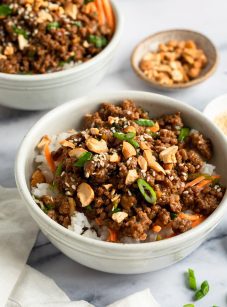
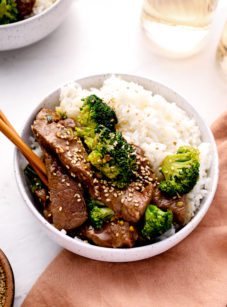
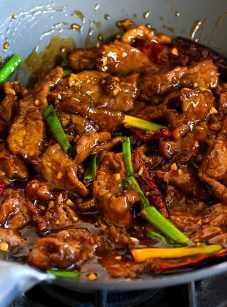
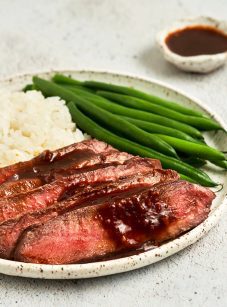

Excellent recipe, super easy instructions and most of the ingredients were already in my kitchen. I made this for dinner tonight for my husband and daughter, and it was a huge success 🙌 I doubled the marinade and it made for perfect seasoning! I served this with broccolini & carrots and jasmine rice. Thank you!!!
Made this last night for the first time. Used flat iron steak and marinated the meat for two days(wasn’t intentional, but was awesome). Was so good my wife and I ate every bit. Served it with rice, made it into lettuce wraps with Romaine, and bean sprouts. Made Oi Muchem (Spicy cucumbers) as a side. So good. Definitely going on permanent rotation.
Delicious, great flavor, straightforward preparation. Its a great way to expand the palate of unadventurous eaters without going ‘too far’
This is an excellent recipe. Very tasty and a bit spicy, which you can control.
Hi Jenn, I love all your recipes. My husband always asks “Is this your girlfriend’s recipe?” and I always say yes! I was wondering if this could be made not using beef? If so, what type of meat and cut would you use, my daughter doesn’t eat beef. Thank you
Aww…I love that your husband asks that! I think this would work with sliced chicken thighs. I’d love to hear how it turns out if you try it!
Outstanding!!! The beef was incredibly tender and the sauce was amazing! I made the recipe with 1# of sliced beef – so I had extra marinade to heat at the end. Next time, I’ll do the same AND make another full-marinade recipe so we have even more sauce at the end. It’s that good!!! Bravo!